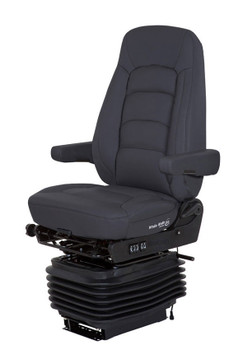2007-2009
The Peterbilt 335 is a Class 6 or Class 7 medium-duty truck, known for its durability, flexibility, and clean styling. It was a predecessor to the 330 and 337 in Peterbilt’s medium-duty lineup, offering a reliable chassis for a wide range of vocational and delivery-based work.
The 335 has long been a fleet favorite for:
- Regional and local delivery (box/reefer)
- Rollback and towing
- Utility service trucks
- Dump and landscape trucks
- Tanker and vacuum trucks
- Municipal and fire/rescue applications
Its combination of size, GVWR options (up to ~33,000 lbs), and Peterbilt’s build quality made it a versatile choice for operators who needed dependable performance in both city and highway environments.
Cab Type:
The Peterbilt 335 uses the 1.9-meter (76") narrow vocational cab, shared with the 325, 330, and 337 models. While compact, it’s built with the same aluminum cab structure Peterbilt is known for, and it can be spec’d with basic or premium trim packages.
Aftermarket Seat Compatibility:
Since the 335 uses the 1.9-meter narrow cab, it has a standard vocational seat bolt pattern, typically around 4.68" x 12". This makes it compatible with a wide range of aftermarket seat models, particularly those designed for vocational or medium-duty use.
Popular aftermarket seat options for the 335:
- Knoedler Harrier – a low-profile air ride seat ideal for limited headroom
- National Corsair or Ensign – mechanical and air ride options with narrow base fitment
- Bostrom Wide Ride Core or T-Series – may need a low-profile base or adaptor depending on cab layout
Installation Notes:
- Most aftermarket seats will fit directly.
- Ensure seat width and suspension height work with the cab’s floor-to-ceiling space.
- Some 335 models have HVAC or battery boxes under the seat—check for interference before installation.
- Low-profile seats are often preferred for headroom and entry ease.
-

Bostrom Baja Standard (choose your options)
Bostrom Seating
Your Price: $679.00 - $1,067.00Bostrom’s Baja Series is the perfect blend of simplicity, durability, and comfort. The Baja’s ergonomic seat and Flex Support Cushion System reduce back stress, allowing you to maintain focus on the road. With its scissor action...12470xxYour Price: $679.00 - $1,067.00 -

Bostrom Patriot Standard (choose your options)
Bostrom Seating
Your Price: $976.00 - $1,171.00Perfect for local driving - The Patriot from Bostrom Seating! The Patriot seat offers the ultimate mix of features and functions for rugged and local delivery applications. Durable fabrics are available with flatter cushion side bolsters to...23560xxYour Price: $976.00 - $1,171.00 -

Bostrom ProRide Standard (choose your options)
Bostrom Seating
Your Price: $1,100.00 - $2,530.00The Bostrom Pro Ride delivers superior comfort for professional drivers. The Pro Ride’s combination of ergonomic cushions and Flex Support System reduces discomfort and fatigue – which means more up time for you! Pro Ride’s two...93xxxxxYour Price: $1,100.00 - $2,530.00 -

Bostrom T-Series T915 ADJUSTABLE SHOCK (choose your options)
Bostrom Seating
Your Price: $938.00 - $1,048.00Drive for miles enjoying Bostrom Seating's T Series. The T Series has proven durability and comfort. Its Flex Support Cushion System reduces cushion compression so that you are able to ride longer. Scissor action suspension delivers superior...23392xx-xxxYour Price: $938.00 - $1,048.00 -

Bostrom T-Series T915 Driver Swivel (choose your options)
Bostrom Seating
Your Price: $996.00 - $1,140.00Drive for miles enjoying Bostrom Seating's T Series with Driver Swivel. The T Series has proven durability and comfort. Its Flex Support Cushion System reduces cushion compression so that you are able to ride longer. Scissor action...234107X-XXXYour Price: $996.00 - $1,140.00 -

Bostrom T-Series T915 DUAL DAMPER (choose your options)
Bostrom Seating
Your Price: $830.00 - $978.00Drive for miles enjoying Bostrom Seating's T Series. The T Series has proven durability and comfort. Its Flex Support Cushion System reduces cushion compression so that you are able to ride longer. Scissor action suspension delivers superior...2324XXX-XXXYour Price: $830.00 - $978.00 -

Bostrom T-Series T915 Standard (choose your options)
Bostrom Seating
Your Price: $773.00 - $1,435.00Drive for miles enjoying Bostrom Seating's T Series. The T Series has proven durability and comfort. Its Flex Support Cushion System reduces cushion compression so that you are able to ride longer. Scissor action suspension delivers superior...23xxxxx-xxxYour Price: $773.00 - $1,435.00 -

Bostrom Wide Ride + Serta (choose your options)
Bostrom Seating
Your Price: $0.00 - $2,223.00Bostrom's Wide Ride + Serta redefines premium seating in the trucking industry. Bostrom Seating is redefining seat comfort with the ultimate Wide Ride Plus Serta® Cool ActionTM Gel Memory foam. Ultimate comfort through the...51xxxxxYour Price: $0.00 - $2,223.00 -

Bostrom Wide Ride + Serta with Heating and Venting (Choose your options)
Bostrom Seating
Your Price: $3,010.00 - $3,249.00Bostrom's Wide Ride + Serta and heat/venting redefines premium seating in the trucking industry. Bostrom partnered with Serta to develop the most comfortable truck seat in the market. They have integrated Serta's Cool Action Gel memory foam with their...5X00X2XYour Price: $3,010.00 - $3,249.00 -

Bostrom Wide Ride Core (choose your options)
Bostrom Seating
Your Price: $0.00 - $1,909.00Bostrom Wide Ride Core - New Technology, New Style, Smarter than Ever from Bostrom Seating If you are in and out of the cab frequency - The new Wide Ride CORE with Dump and Memory switch may be the right seat for you. The Wide Ride CORE provides...5Ax9xxxYour Price: $0.00 - $1,909.00 -

Bostrom Wide Ride Core Hi Pro, swivel ultra leather Grey
Bostrom Seating
Your Price: $1,515.00Bostrom Wide Ride Core - New Technology, New Style, Smarter than Ever from Bostrom Seating If you are in and out of the cab frequency - The new Wide Ride CORE with Dump and Memory switch may be the right seat for you. The Wide Ride CORE provides...5B09171-902 In StockYour Price: $1,515.00 -

GraMag Black Genuine Leather with Heat and Vent Option Truck Seat
GRAMAG
Your Price: $1,805.00 - $2,225.00GraMag new semi truck seat in black Genuine Leather with black/grey/tan stitching with air suspension for aftermarket seating for International, Freightliner, Kenworth, Volvo, Peterbilt semi trucks. On-Highway seat ideal for...AF-11003LEYour Price: $1,805.00 - $2,225.00
